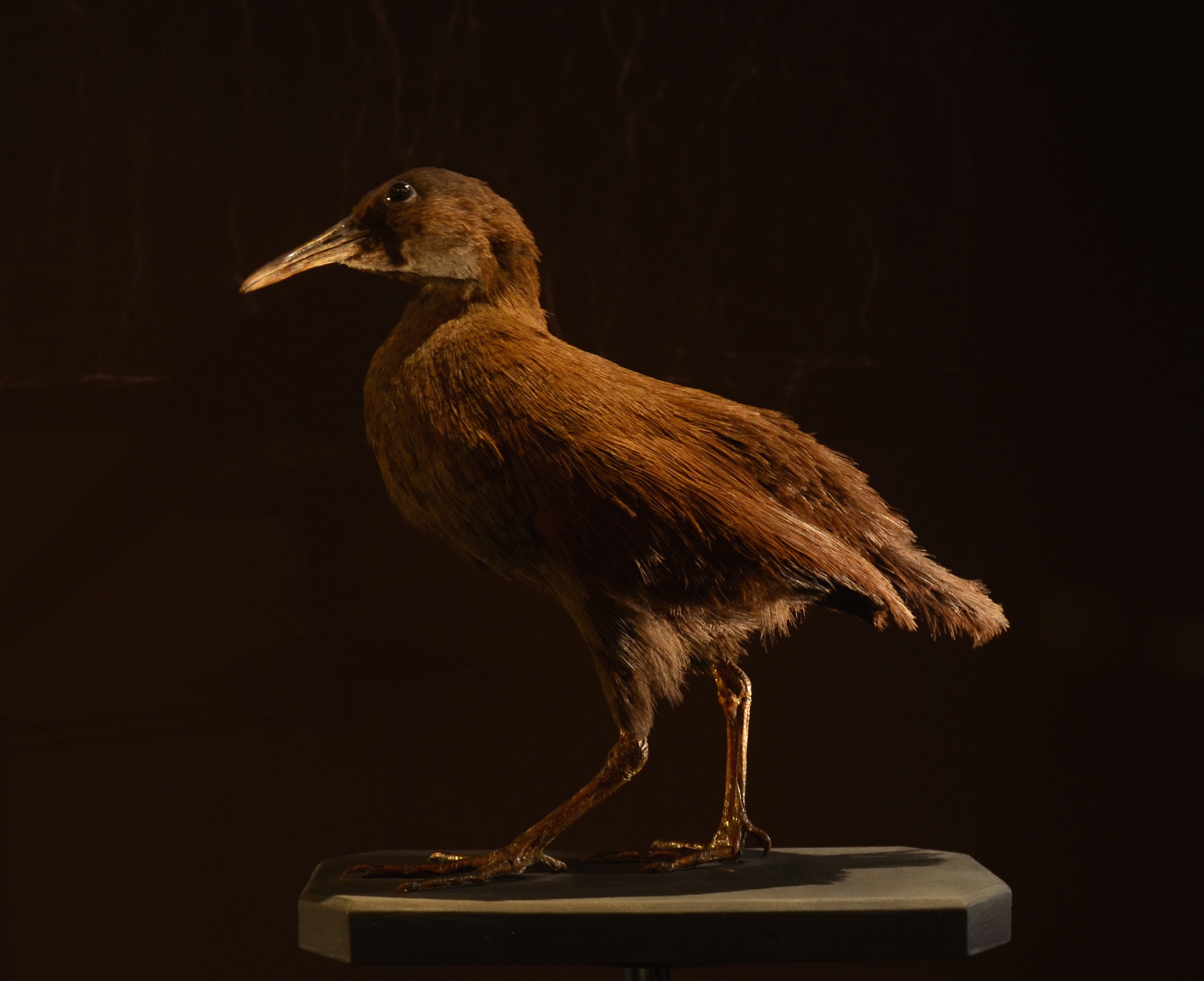Gallirallus lafresnayanus Verreaux & Des Murs, 1860:437
New Caledonian rail, New Caledonian wood rail, n'dini (Layard), n'diou (Jouan)
Taxonomy & Nomenclature
Synonym/s: Tricholimnas lafresnayanus Verreaux & Des Murs, 1860:437; Ocydromus lafresnayanus Verreaux & Des Murs, 1860:437
Conservation Status
Extinct (WCMC, 1992:212)
Last record: 1890 (Martin et al., 2023); 1904 (WCMC, 1992:212)
IUCN RedList status: Critically Endangered
This species was reported by (Anderson et. al. 2010) from layers in which human occupation had long occurred. It can therefore be inferred with some degree of confidence that humans played at least a supporting role in the extinction of this insular taxon, even if only indirectly.
Distribution
New Caledonia
Biology & Ecology
Hypodigm
Natural History Museum, London:
BMNH 70.12.3.3 (male);
BMNH 70.12.3.4 (female)
BMNH 98.12.2.540 (female)
BMNH 1889.11.1.375 (female)
Museum of New Zealand Te Papa Tongarewa, Wellington:
Unregistered fossil bones from Pindai Cave, New Caledonia according to (Worthy, 2004).
Total specimens:
According to (Fulgar et. al. 1982: 131) at least 16 specimens, and possibly 17, were deposited in various museums around the world:
"We have examined a total of twelve T. lafresnayanus in world museums. Two others have been traced and a third possibly exists. Two more have been destroyed."
Media

Above: preserved specimen in the Museum National d'Histoire Naturelle, Paris. Photo by Vassil 2013. Source: Wikimedia Commons.
References
Original scientific description:
Verreaux, J. and Des Murs, O. (1860). Description d'oiseaux nouveaux de la Nouvelle Calédonie et indication des espéces déjà connues de ce pays. Reveu et Magasin de Zoologie 2(12): 431-443.
Other references:
Anderson, Atholl, Sand, Christophe, Petchey, Fiona and Worthy, Trevor H. (2010). Faunal Extinction and Human Habitation in New Caledonia: Initial Results and Implications of New Research at the Pindai Caves. Journal of Pacific Archaeology 1(1): 89-109.
Balouet, Jean Christophe and Olson, Storrs L. (1989). Fossil Birds from Late Quaternary Deposits in New Caledonia. Smithsonian Contributions to Zoology 469: 1-38, 16 figures, 13 tables.
BirdLife International (2000) Threatened Birds of the World. Lynx Edicions and BirdLife International, Barcelona and Cambridge.
BirdLife International. (2012). Gallirallus lafresnayanus. In: IUCN 2013. IUCN Red List of Threatened Species. Version 2013.1. (http://www.iucnredlist.org). Downloaded on 24 August 2013.
Butchart, Stuart H. M., Lowe, Stephen, Martin, Rob W., Symes, Andy, Westrip, James R. S. and Wheatley, Hannah. (2018a). Which bird species have gone extinct? A novel quantitative classification approach. Biological Conservation 227: 9-18. https://doi.org/10.1016/j.biocon.2018.08.014
Butchart, Stuart H. M., Wheatley, Hannah, Lowe, Stephen, Westrip, James R. S., Symes, Andy and Martin, Rob W. (2018b). Data for: Which bird species have gone extinct? A novel quantitative classification approach. Mendeley Data, V1, doi: 10.17632/vvjhpmyxb4.1
Ekstrom, J.M.M., Jones, J.P.G., Willis, J., Tobias, J., Dutson, G., & Barré, N. (2002). New information on the distribution, status and conservation of terrestrial bird species in Grande Terre, New Caledonia. Emu 102: 197–207.
Fullagar, P. J., Disney, H. J. S. and Naurois, R. D. (1982). Additional specimens of two rare rails and comments on the genus Tricholimnas of New Caledonia and Lord Howe Island. Emu 82(3): 131-136. [Abstract]
Greenway, J. C. (1967). Extinct and Vanishing Birds of the World. New York: Dover Publications.
Hume, Julian Pender and Walters, Michael. (2012). Extinct Birds. London: T & AD Poyser.
Jouanin, Christian. (1962). Inventaire des oiseaux éteints ou en voie d’extinction conservés au Muséum de Paris. Terre et Vie 109: 275-301.
Knox, Alan G. and Walters, Michael P. (1994). Extinct and endangered birds in the collections of The Natural History Museum. British Ornithologists' Club Occasional Publications 1: 1-292.
Layard, E. L. and Layard, E. C. L. (1882). Notes on the Avifauna of New Caledonia. Ibis 6(4S): 493-546.
Martin, Thomas E., Bennett, Gareth C., Fairbairn, Andrew J. and Mooers, A. Ø. (2023). ‘Lost’ taxa and their conservation implications. Animal Conservation 26(1): 14-24. https://doi.org/10.1111/acv.12788 [Appendix S2 (1617 taxa not seen >10 years); Appendix S3 (562 taxa not seen >50 years)]
Sclater, P. L. (1869). [New Caledonia rail Ocydromus lafresnayanus]. Proceedings of the Zoological Society of London [1869]: 431.
Steadman DW (2006) Extinction and Biogeography of Tropical Pacific Birds. University of Chicago Press, Chicago.
Stokes, T. (1979). On the possible existence of the New Caledonian Wood Rail Tricholimnas lafresnayanus. Bull. Br. Ornithol. Cl. 99: 47-54.
Tyrberg, Tommy. (2009). Holocene avian extinctions, pp. 63-106. In: Turvey, Samuel T. (ed.). Holocene Extinctions. Oxford, UK & New York, USA: Oxford University Press. xii + 352 pp.
WCMC (World Conservation Monitoring Centre). (1992). Global Biodiversity: Status of the Earth's living resources. London: Chapman & Hall. xx + 594 pp.
Worthy, Trevor H. (2004). The fossil rails (Aves: Rallidae) of Fiji with descriptions of a new genus and species. Journal of the Royal Society of New Zealand 34(3): 295–314.
